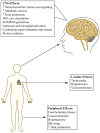Methamphetamine-induced toxicity: an updated review on issues related to hyperthermia
- PMID: 24836729
- PMCID: PMC4700537
- DOI: 10.1016/j.pharmthera.2014.05.001
Methamphetamine-induced toxicity: an updated review on issues related to hyperthermia
Abstract
Reports of methamphetamine-related emergency room visits suggest that elevated body temperature is a universal presenting symptom, with lethal overdoses generally associated with extreme hyperthermia. This review summarizes the available information on methamphetamine toxicity as it pertains to elevations in body temperature. First, a brief overview of thermoregulatory mechanisms is presented. Next, central and peripheral targets that have been considered for potential involvement in methamphetamine hyperthermia are discussed. Finally, future areas of investigation are proposed, as further studies are needed to provide greater insight into the mechanisms that mediate the alterations in body temperature elicited by methamphetamine.
Keywords: Autonomic nervous system; Hyperthermia; Methamphetamine; Reactive oxygen species; Thermoregulation; Toxicity.
Copyright © 2014 Elsevier Inc. All rights reserved.
Conflict of interest statement
The authors have no conflicts of interest to disclose.
Figures

Similar articles
-
Methamphetamine-induced hyperthermia and lethal toxicity: role of the dopamine and serotonin transporters.Eur J Pharmacol. 2007 Oct 31;572(2-3):120-8. doi: 10.1016/j.ejphar.2007.06.022. Epub 2007 Jun 27. Eur J Pharmacol. 2007. PMID: 17673199
-
Involvement of glucocorticoid receptor on hyperpyrexia induced by methamphetamine administration.Soud Lek. 2012 Oct;57(4):66-8. Soud Lek. 2012. PMID: 23121037
-
Methamphetamine treatment during development attenuates the dopaminergic deficits caused by subsequent high-dose methamphetamine administration.Synapse. 2011 Aug;65(8):771-7. doi: 10.1002/syn.20902. Epub 2011 Mar 21. Synapse. 2011. PMID: 21190217 Free PMC article.
-
Neurotoxicology of Synthetic Cathinone Analogs.Curr Top Behav Neurosci. 2017;32:209-230. doi: 10.1007/7854_2016_21. Curr Top Behav Neurosci. 2017. PMID: 27753008 Free PMC article. Review.
-
Acute methamphetamine intoxication: brain hyperthermia, blood-brain barrier, brain edema, and morphological cell abnormalities.Int Rev Neurobiol. 2009;88:65-100. doi: 10.1016/S0074-7742(09)88004-5. Int Rev Neurobiol. 2009. PMID: 19897075 Free PMC article. Review.
Cited by
-
Drug- and/or trauma-induced hyperthermia? Characterization of HSP70 and myoglobin expression.PLoS One. 2018 Mar 22;13(3):e0194442. doi: 10.1371/journal.pone.0194442. eCollection 2018. PLoS One. 2018. PMID: 29566034 Free PMC article.
-
Neuroprotective Effects of Anti-high Mobility Group Box-1 Monoclonal Antibody Against Methamphetamine-Induced Dopaminergic Neurotoxicity.Neurotox Res. 2021 Oct;39(5):1511-1523. doi: 10.1007/s12640-021-00402-5. Epub 2021 Aug 21. Neurotox Res. 2021. PMID: 34417986
-
Psychostimulants for Children: Are We Over or Under Dosing?J Addict Psychiatry. 2023;7(1):1-4. Epub 2023 Apr 22. J Addict Psychiatry. 2023. PMID: 37560458 Free PMC article.
-
Extreme Hyperthermia Due to Methamphetamine Toxicity Presenting As ST-Elevation Myocardial Infarction on EKG: A Case Report Written With ChatGPT Assistance.Cureus. 2023 Mar 13;15(3):e36101. doi: 10.7759/cureus.36101. eCollection 2023 Mar. Cureus. 2023. PMID: 37065364 Free PMC article.
-
Combined and sequential effects of alcohol and methamphetamine in animal models.Neurosci Biobehav Rev. 2021 Dec;131:248-269. doi: 10.1016/j.neubiorev.2021.09.019. Epub 2021 Sep 17. Neurosci Biobehav Rev. 2021. PMID: 34543650 Free PMC article. Review.
References
-
- Ago Y, Nakamura S, Uda M, Kajii Y, Abe M, Baba A, Matsuda T. Attenuation of the 5-HT1A receptor agonist osemozotan of the behavioral effects of single and repeated methamphetamine in mice. Neuropharmacol. 2006;51:914–922. - PubMed
-
- Albers DS, Sonsalla PK. Methamphetamine-induced hyperthermia and dopaminergic neurotoxicity in mice: pharmacological profile of protective and nonprotective agents. J Pharmacol Exp Ther. 1995;275:1104–1114. - PubMed
-
- Ares-Santos S, Granado N, Oliva I, O’Shea E, Martin ED, Colado MI, Moratalla R. Doapmine D1 receptor deletion strongly reduces neurotoxic effects of methamphetamine. Neurobiol Dis. 2012;45:810–820. - PubMed
-
- Azzaro AJ, Rutledge CO. Selectivity of release of norepinephrine, dopamine, and 5-hydroxytryptamine by amphetamine in various regions of rat brain. Biochem Pharmacol. 1973;22:2801–2813. - PubMed
Publication types
MeSH terms
Substances
Grants and funding
LinkOut - more resources
Full Text Sources
Other Literature Sources
Medical

